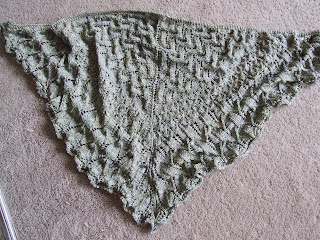Heeeere she is... the Norwegian Woods scarf in peridot sea silk with 8/0 silver lined crystal triangle beads. And a closer picture of the beaded scallops..
And a closer picture of the beaded scallops..
Sorry I couldn't get a modeled shot, but it was just me taking the pics this morning. The black chair had to do.
Now to answer the excellent questions from the last post...
Query: Why did you choose to pin the scallop points with individual pins, rather than threading additional blocking wires through the points, and gently curving those wires? This is an honest question, not a critique! The shawl is stunning, and I hope to make one of my own.
Kristen, this is such a good question and one that I have given a lot of thought. I have tried blocking with wires, once, briefly, but found unfortunately that my blocking wires (you may have more flexible ones than I do however) did not bend to the extent that I needed to form the rather deep scallops. I could have used them if I wanted to bend them forever to that shape.. hmm, that is a thought!
As the Moonshadow has somewhat the same shape edge to block, I did try several alternate methods of blocking those scallops. The best "run-through" method turned out to be fishing line, which makes the edge more substantial, but I STILL had to use pins to get the shape to stay properly round. Lesson learned.. this time, only humble pins, which seem to get around the curves the best of any method, as far as I am concerned. You could certainly use blocking wires to line up the edges of the curves into a straight line, but I feel that this might give your scallops a pointy look if you aren't careful.
I like the very organic looking curves I get with pins. But please... experiment with other methods, and please report back to me about what you find. This is all about learning, after all.
jenknits, I did leave out the part about endless pinning and repinning to get the darn thing symmetrical! Now you know... the secret is out.
Happy scalloping day to all...

















